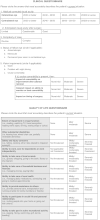Predicting changes in cataract surgery health outcomes using a cataract surgery appropriateness and prioritization instrument
- PMID: 33507910
- PMCID: PMC7842922
- DOI: 10.1371/journal.pone.0246104
Predicting changes in cataract surgery health outcomes using a cataract surgery appropriateness and prioritization instrument
Abstract
Objective: Determine whether items in a cataract surgery appropriateness and prioritization questionnaire can predict change in best corrected visual acuity (BCVA) and health related quality of life (HRQOL) following cataract surgery.
Methods: 313 patients with a cataract in Ontario, Canada were recruited to participate. BCVA was measured using the Snellen chart. HRQOL was measured using a generic instrument (EQ5D), a visual functioning instrument (Catquest-9SF), and an appropriateness and prioritization instrument (17 items). Outcomes were measured preoperatively and 3-6 months postoperatively. Descriptive statistics were used to describe demographics and outcomes. For each appropriateness and prioritization questionnaire item, a one-way ANOVA was used to compare group means of the change in BCVA, EQ5D, and Catquest-9SF.
Results: Participants had a mean age of 69 years and were 56% female. BCVA improved in 81%, EQ5D in 49.6%, and Catquest-9SF score in 84% of patients. Improvement in both BCVA and Catquest-9SF scores were found in 68.5% of patients. The ANOVA showed a statistically significant association between a change in BCVA and the ability to participate in social life, and a statistically significant association between a change in Catquest-9SF and glare, extent of impairment in visual function, safety and injury concerns, ability to work and care for dependents, ability to take care of local errands, ability to assist others and ability to participate in social life.
Conclusions: Almost all patients had improved BCVA and/or visual functioning after surgery. Seven variables from the cataract appropriateness and prioritization instrument were found to be predictors of improvement in Catquest-9SF measuring visual functioning.
Conflict of interest statement
I have read the journal’s policy and the authors of this manuscript have the following competing interests: Iqbal Ahmed: Consultant/Consulting Fees: Arucela, Aerie Pharmaceuticals, Alcon, Allergan, ArcScan, Bausch and Lomb, Beaver Visitec, Camras Vision, Carl Zeiss Meditec, Centervue, Ellex, ElutiMed, Equinox, Foresight Labs, Genentech, Glaukos, Gore, Iantech, InjectSense, Iridex, iStar, Ivantis, Johnson and Johnson Vision, KeLoTec, LayerBio, Leica Microsystems, MicroOptx, New World Medical, Omega Ophthalmics, PolyActiva, Sanoculis, Santen, Science Based Health, Sight Sciences, Stroma, True Vision, Vizzario. Speakers Honoraria: Alcon, Allergan, Carl Zeiss Meditec, Johnson and Johnson Vision. Research Grant/Support: Aerie Pharmaceuticals, Alcon, Allergan, Camras Vision, Glaukos, Ivantis, Johnson and Johnson Vision, New World Medical, Santen. Matthew B. Schlenker: Consulting: Alcon, Allergan, Light Matter Interaction, Santen. Honorarium: Alcon, Allergan, Aequus, J&J, Thea-Labtician. All other authors report no proprietary or commercial interest in any product mentioned or concept discussed in this article. This does not alter our adherence to PLOS ONE policies on sharing data and materials.
Figures
References
-
- Ontario Ministry of Health and Long-Term Care. Initial Report on Public Health. 2009.
Publication types
MeSH terms
LinkOut - more resources
Full Text Sources
Other Literature Sources
Medical





